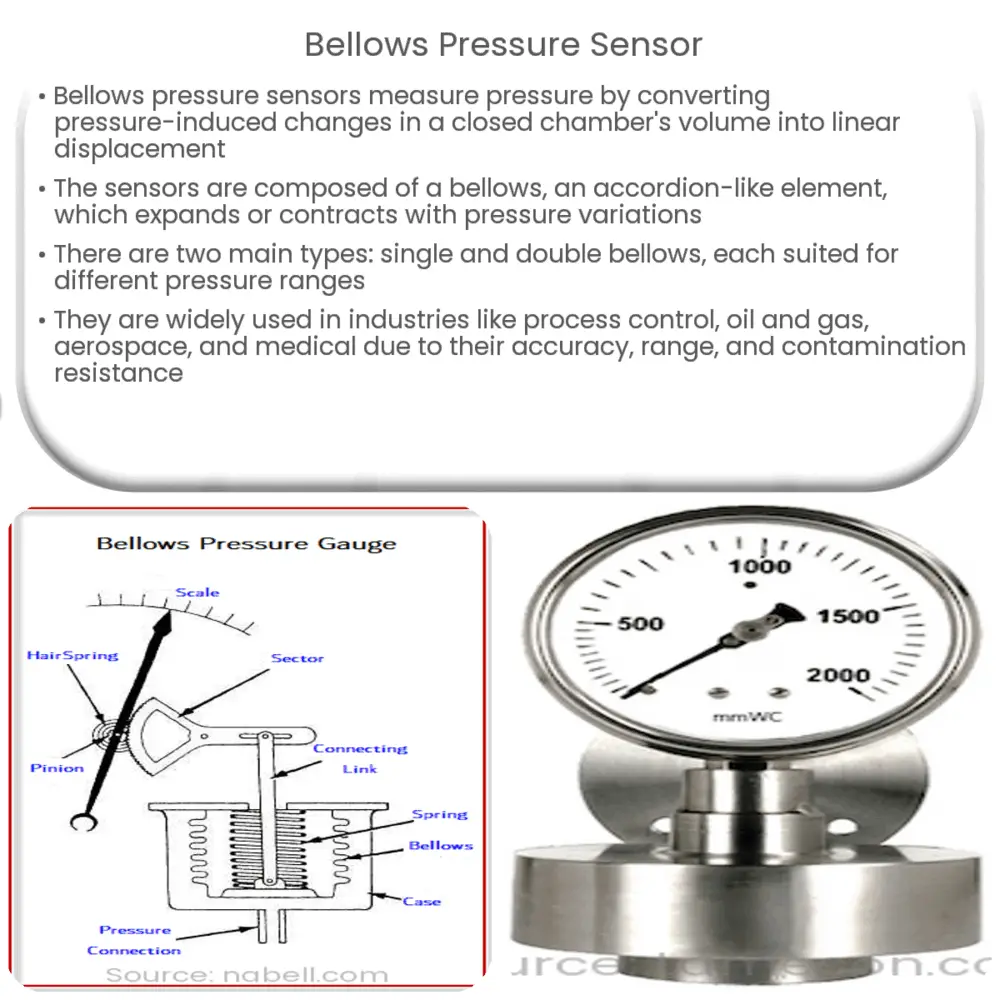Bellows pressure sensors accurately measure pressure by converting volume changes in a flexible, convoluted chamber into linear displacement.

Bellows Pressure Sensor: An Introduction to its Functionality and Applications
Pressure sensors play a crucial role in various industries, and there are several types available to cater to different needs. One such type is the bellows pressure sensor, known for its accuracy, reliability, and versatility. In this article, we delve into the fundamentals of bellows pressure sensors, discussing their construction, working principle, and applications across a range of industries.
Construction and Working Principle
A bellows pressure sensor is a mechanical device designed to measure pressure by converting the pressure-induced change in the volume of a closed chamber into a linear displacement. The primary component of a bellows pressure sensor is the bellows, a flexible, tubular element with accordion-like folds made of metal or other elastic materials. These folds, also known as convolutions, allow the bellows to expand or contract in response to pressure changes.
The working principle of a bellows pressure sensor is based on the deformation of the bellows under varying pressure conditions. When the pressure inside the chamber increases, the bellows expand, causing a linear displacement that can be measured using a mechanical linkage or an electrical transducer. Similarly, a decrease in pressure leads to the contraction of the bellows, resulting in a measurable displacement in the opposite direction.
One end of the bellows is sealed and attached to a pressure port, while the other end connects to a mechanical or electrical measurement system. The pressure-induced deformation of the bellows is transmitted to the measurement system, which then converts the displacement into an electrical signal proportional to the applied pressure. This signal is then processed and displayed as a pressure reading.
Types of Bellows Pressure Sensors
There are two main types of bellows pressure sensors: single bellows and double bellows. The primary difference between the two lies in their construction and pressure range capabilities.
Single Bellows: In a single bellows pressure sensor, a single tubular bellows element is used to measure pressure changes. These sensors are ideal for low to medium pressure ranges and are typically more compact and cost-effective than double bellows sensors.
Double Bellows: Double bellows pressure sensors consist of two bellows elements connected in series, with one bellows enclosed within the other. This arrangement allows the sensor to measure higher pressure ranges and provide increased sensitivity and accuracy. Double bellows sensors are commonly used in applications where precise pressure measurements are required.
Applications of Bellows Pressure Sensors
Thanks to their accuracy, reliability, and versatility, bellows pressure sensors find applications across a wide range of industries. Some of these include:
- Process Control: Bellows pressure sensors are used in industrial process control systems to monitor and regulate pressure in piping systems, reactors, and vessels.
- Oil and Gas: These sensors are employed in various stages of oil and gas production, from drilling to refining and distribution, ensuring safe and efficient operations.
- Chemical: In the chemical industry, bellows pressure sensors are used to measure and control pressure in reactors, distillation columns, and other critical processes.
Aerospace and Aviation
In aerospace and aviation, bellows pressure sensors are employed to measure and monitor altitude, cabin pressure, and fuel tank pressure, ensuring the safety and comfort of passengers and crew members.
HVAC and Refrigeration
In heating, ventilation, air conditioning (HVAC), and refrigeration systems, bellows pressure sensors help maintain optimal operating conditions by monitoring pressure levels in various components such as compressors, condensers, and evaporators.
Medical
In the medical field, bellows pressure sensors are utilized in a variety of applications such as blood pressure monitoring, respiratory equipment, and infusion pumps. Their accuracy and reliability are critical in ensuring proper patient care and treatment.
Advantages of Bellows Pressure Sensors
Bellows pressure sensors offer several advantages over other types of pressure sensors, making them a popular choice for various applications:
- High Accuracy: Due to their construction and working principle, bellows pressure sensors are capable of providing highly accurate pressure measurements, making them ideal for applications requiring precise readings.
- Wide Pressure Range: With the availability of single and double bellows configurations, these sensors can cater to a wide range of pressure requirements, from low to high-pressure applications.
- Temperature Compensation: Bellows pressure sensors can be designed with built-in temperature compensation mechanisms, minimizing the effects of temperature fluctuations on pressure readings.
- Resistance to Contamination: The sealed construction of bellows pressure sensors prevents contamination from dust, moisture, and other particles, ensuring reliable operation even in harsh environments.
Conclusion
Bellows pressure sensors are a versatile and reliable choice for a wide range of industries and applications. Their unique construction, working principle, and inherent advantages make them an attractive option for pressure measurement tasks requiring high accuracy and reliability. As technology continues to advance, we can expect to see further improvements in the design and capabilities of bellows pressure sensors, expanding their potential use cases and enhancing their performance in existing applications.

